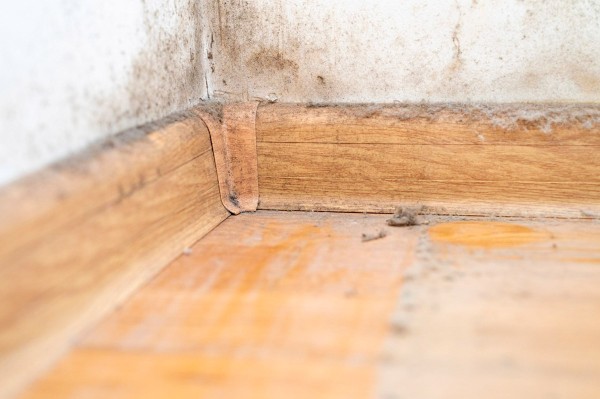It is not at all uncommon for white or green mold to disfigure baseboards. Sometimes there is also mold behind baseboards. This is not a purely visual problem, because mold can be harmful to health. Why mold forms behind baseboards or on them and what to do about it, read here.
Mold on baseboards: What are the causes?
When mold disfigures baseboards or the mold appears behind baseboards, it can have different reasons. However, all of them have one basic cause: there is increased moisture in the room, which is reflected in the masonry or building fabric. Sometimes mold is formed on, behind and around baseboards, for example, because there was very heavy rainfall. In other situations, mold forms on the baseboards over a long period of time. If this is the case, moisture accumulates in the masonry or in the floor. This must now be located as quickly as possible in order to initiate a drying and remediation process.
Three very common causes of high moisture and thus the formation of mold around baseboards are:
- Moisture rising through the floor. Failure to waterproof foundations and walls causes the building fabric to act like a sponge and soak up ground or slope water. This allows moisture to rise over time, causing mold at baseboards and mold behind baseboards.
- Mold on baseboards can be a consequence of new construction moisture. A lot of water is required for the concrete of a new building. If mortar, screed or other building materials do not dry properly, more moisture will develop later. At some point, mold can then cover baseboards.
- If the underfloor heating system is defective, water from the pipes and hoses will get into the floor and soak it. Spores thrive underneath the flooring and eventually show up as mold behind baseboards or on top of them.
Risk of moldy baseboards: how to recognize it?
Sometimes green mold literally covers baseboards. In some cases, discoloration and thus mold residue show up above the baseboard. In some cases, however, it's harder to spot the spores. Why? Because the mold has formed behind baseboard. Often, the occupants of the house then only perceive an unpleasant odor. If this is the case, it can take weeks or months to identify the mold source. In this way, the mold can continue to spread in peace and cause expensive damage in the end. Therefore, it is better to check your baseboards once more if you notice unpleasant odors.
Mold baseboards: how to remove it and what is important in the process?
Removing mold from baseboards doesn't have to be difficult. It depends on the damage left by the mold. If there is only a light infestation, it is enough to disassemble the baseboards and clean them with high-proof alcohol. If the mold damage is more extensive, this procedure is not sufficient. Especially if mold shows up behind baseboards, there is a good chance that parts of the floor will also need mold treatment. In some cases, this may require the use of a building dryer. Mold-killing agents may also be required. If mold exists on baseboards on a first floor that does not have a basement, it is advisable to look for rising damp and have it remedied.
Caution: No matter where the mold has stained baseboards, wearing a protective mask is mandatory when cleaning. There is a health hazard due to the spores. Action should be taken promptly, because existing mold in the room harms the well-being and can even provoke disease.
If mold covers skirting boards: Do the moldings need to be replaced?
That depends on the individual case. If it is superficial discoloration on the moldings, thorough cleaning and subsequent drying of the room is sufficient. If the mold on baseboards is more persistent and the basic problem is more serious, the only solution is usually to replace the baseboards. However, this should be done only after all the work to eliminate the basic problem has been completed.
In addition to the extent of the mold problem, the type of baseboard plays a role:
- Baseboards made of plastic are easy to clean and reinstall.
- Baseboards made of MDF usually need to be replaced, as mold can easily move in here.
- Replacement of baseboards made of solid wood is advisable as soon as the mold sits deep in the natural material.
How can mold on baseboards be prevented?
The best mold prevention is dry rooms and careful construction. Building materials and construction techniques exist that can effectively reduce the risk of mold. In rooms such as bathrooms and kitchens, skirting boards made of plastic are particularly recommended. If superficial mold forms there due to splash or plaster water, it can be removed quickly and easily.

